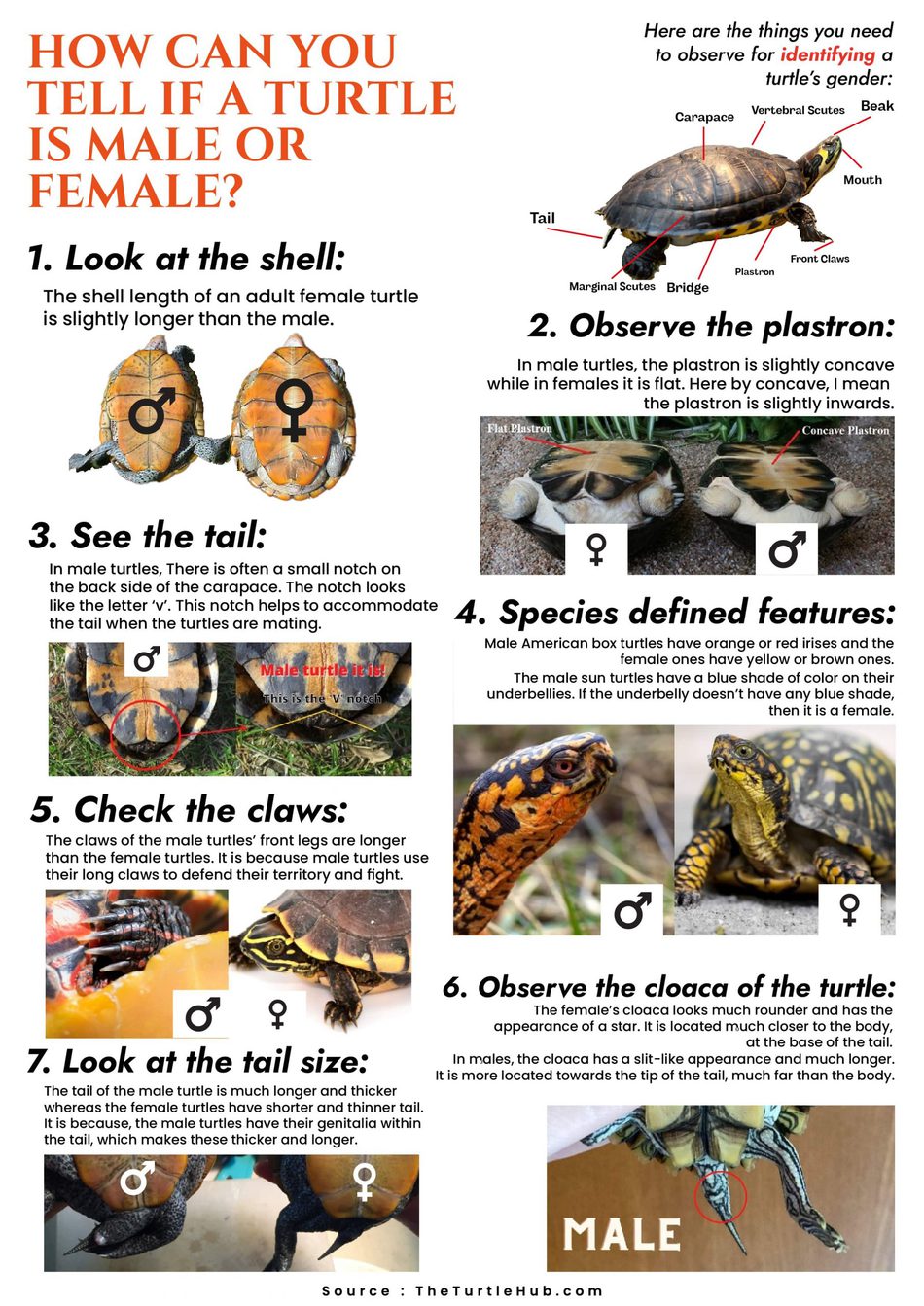Tags:
How To Determine Snapping Turtle Gender?


fact checked & review by
Dr. Partho Kumar Shaha
Veterinarian (DVM)
The information is current and up-to-date in accordance with the latest veterinarian research.
Have you just bought a snapping turtle? Or are you thinking about breeding the species? In any case, sexing the turtle is mandatory. Identifying the gender of a snapping turtle might be a little challenging for the newbies unless you know the tricks. So, how to determine the spanning turtle gender without hassle?
Male snapping turtles are usually larger than the females. Their tails are longer than those of the females. Females, however, have flat plastrons. Males, in contrast, have curved plastrons.
Want to know more details on sexing a snapping turtle? Continue reading the article to the end.
key takeaways
- Male snapping turtles are generally larger than females, showing noticeable differences in size and weight.
- The tail of male snapping turtles is longer and thicker than that of females.
- Male snapping turtles have their cloaca closer to the tail tip, while females have it nearer to the plastron edge.
- The bottom shell of male snapping turtles is curvy, contrasting with the flat plastron of females.
- Male snapping turtles exhibit more aggressive reproductive behavior compared to females.
How To Determine Snapping Turtle Gender?
Snapping turtles exhibit sexual dimorphism. It means the males and females have key differences between them. Thanks to their biological characteristics, that made the whole sexing thing easier.
I know you are keen to learn how to determine the snapping turtle gender. But first, let me clear a fact real quick.
Snapping turtles species have two subspecies,
- Common snapping turtle (Chelydra Serpentina)
- Alligator snapping turtle (Macrochelys Temminckii)
Both the subspecies have a few characteristics differences between them. Hence, the sexing of one subspecies might slightly vary from the other one. But yes, on the bigger picture, the idea of determining snapping turtle gender is the same.
So, I recommend you first identify your turtle species and subspecies. Then continue the gender determination process. Check this article for a complete turtle identification guide.
So, how to sex a snapping turtle? Well, experts have come up with 4 tricks that might help you determine the gender of a snapping turtle,
- Size And Weight
- Tail Structure
- Vent location
- Plastron Shape
- Reproduction behavior
To create a comparative table highlighting the differences between male and female snapping turtles, I will organize the information you provided into a clear and concise format:
| Feature | Male Snapping Turtles | Female Snapping Turtles |
|---|---|---|
| General Size | Larger than females | Smaller than males |
| Common Snapping Turtles Size | 8 to 20+ inches in carapace length | 6.5 to 18 inches in carapace length |
| Weight (Common Snapping Turtle) | Heavier than females | Lighter than males |
| Alligator Snapping Turtles Size | Can reach up to 31 inches | Only reach up to 22 inches |
| Weight (Alligator Snapping Turtle) | Can grow up to 110 kg | Average weight around 50 kg |
| Tail Characteristics | Longer and thicker tail | Shorter and thinner tail |
| Cloaca Position | Closer to the tail tip | Closer to the plastron edge |
| Plastron Shape | Curvy bottom shell | Flat plastron |
| Reproductive Behavior | More aggressive, initiates mating | May defend or act aggressively if not interested |
Unlike humans, snapping turtle sex is determined by environmental temperatures during embryonic development rather than by chromosomes. Colder temperatures result in more male hatchlings, while warmer temperatures produce more females. (source)
generally male snapping turtles are larger than females
Many turtle keepers believe male and female snapping turtles at the same age grow the same size. But it is not exactly true.
The fact is that healthy male snapping turtles are larger than females, at least in most cases. Apparently, it works for both common snapping turtles and alligator snapping turtles.
The male common snapping turtles grow into 8 to 20 inches or more, while the females have a carapace growth of about 6.5 to 18 inches. As a result, the male turtles weigh more than the females.
Let’s face the fact. Not all snapping turtles have exceptional growth. At the end of the maturity years, both the males and females grow about the same size.
The size range of the common snapping turtles is close. So, it is hard to differentiate them just by measuring the carapace length.
Again, the alligator snapping turtle exhibits the same dimorphic features. The males can reach 31 inches. On the contrary, the female turtles only get to cross 22 inches.
There is a noticeable difference in the weight of the male-female alligator snapping turtles. While the male alligator snapping turtles can grow 110 kgs big, the females have an average weight of 50 kgs.
Hence, size difference can be a major point to consider while sexing the alligator snapping turtles.
Need To Talk With A Turtle Vet Right Now?
male snapping turtles have a longer and thicker tail
The male snapping turtles have a longer and thicker tail than the females. Generally, the tip of the tail crosses the midway of the shell. If you observe the female tails, they are thin and much shorter.
Recent studies have found that agricultural practices and mercury pollution in some areas are altering environmental temperatures and causing populations to have an uneven sex ratio with more male turtles. Mercury pollution causing more snapping turtles to be born male than female. This can threaten population viability as it impacts reproduction. (source)
male cloaca is further down and closer to the tail tip
The vent of the female snapping turtle is closer to the plastron edge. On the other hand, the male cloaca is further down and closer to the tail tip.
In common snapping turtles, this change is noticeable at an early age. But in the case of an alligator snapping turtle, you have to wait until the creature matures.
male snapping turtles have a curvy bottom shell
Apparently, the plastron of the male and female snapping turtles is not the same. The male snapping turtles own a curvy bottom shell, while the females have a flat plastron.
male snapping turtles show more aggressive Reproductive Behavior
The male turtles have an aggressive approach towards mating, and it goes the same for the snapping turtles. These male snapping turtles tease the females and poke them to invite for coitus during the breeding season.
In the wild, the male snappers come close to the basking females, mount them from the back, and tightly clutch the shell with their feet. It is their way of initiating the mating process.
Usually, the interested partners encourage the initiation, and go to the deeper water for coitus. On the other hand, the female turtles might defend or act aggressively towards the male if they do not want to mate.
It is not usual to observe the mating or reproduction behavior of the snapping turtles. Hence, I do not find this technique handy in determining their gender in a captive situation.
Are Male Snapping Turtles Larger Than Females?
The male snapping turtles are larger than the females. These males snapping grow bigger and weigh more than the female turtles at a particular age. It goes for both the snapping turtle subspecies.
Let’s draw a comparison chart.
Common Snapping Turtle Size & Weight: Male vs Female
| Gender | Carapace Length | Weight |
|---|---|---|
| Male | 10 to 20 inches | 6 to 22 kgs |
| Female | 6.5 to 18 inches | 4 to 16 kgs |
Alligator Snapping Turtle Size & Weight: Male vs Female
| Gender | Carapace Length | Weight |
|---|---|---|
| Male | 14 to 20 inches (can grow over 30 inches) | 70 to 80 Kgs (can cross 110 kgs) |
| Female | 14 to 20 inches (can grow over 22 inches) | 25 Kgs (can cross 30 kgs) |
From the above charts, it is clear that the male snapping turtles are larger and weigh more than the females.
Hence, if you want to determine the gender of your snapping turtle, you might compare the size and weight of it first. However, you will need another turtle of the same age for the comparison.
Again, considering the physical appearance does not always provide an accurate answer. It is because many factors control the growth of a snapping turtle. So, what can you do?
I suggest going through the key features that differentiate the gender of a turtle, such as the tail, vent location, and plastron. Observing these characteristics will definitely lead you to the answer you are looking for.
How To Tell If A Baby Snapping Turtle Is Male Or Female?
Honestly, it is hard to differentiate between male and female snapping turtles when they are babies. The turtles exhibit sex dimorphic characteristics when they reach a young age.
Generally, the male snapping turtles are larger than the females even when they belong to the same age category. But yes, it is not an accurate method to sex a snapping turtle.
Factors like vitamin or mineral deficiency and physical sickness can affect their growth.
Observing the tail length, vent location, or plastron shape also helps in sexing the snapping turtle. The male turtles always have a thicker and longer tail.
Also, the vent location is near the tip of the tail and further from the plastron edge. Furthermore, the females have a flat bottom shell, while the males have a curved plastron.
Does Incubation Temperature Affect Baby Snapping Turtle Gender?
Unlike snakes and lizards, the sex chromosome does not decide the gender of a snapping turtle. Scientists claim that the outside environment influences the unborn turtle’s sex. But it happens once the egg is fertilized and on the way to maturing.
As per the rule, low temperature, 71.6 to 80.6 degrees Fahrenheit (22 to 27 degrees Celsius), yields male snapping turtles. On the other hand, temperatures above 86 degrees Fahrenheit or 30 degrees Celcius produce females.
What if you maintain a temperature in between these ranges? The clutch will have both male and female snapping turtles.
Turtle Gender Identification Chart

For a printable version of this amazing visual chart, click here!
how to tell if a turtle is a snapping turtle?
It is important that you know your species first. As I always say, identifying turtle species is easy and fun. You have to learn the trick, and it will stay with you forever.
So, how will you identify snapping turtles? Of course, by observing the physical appearances. Here is what to look for:
| Feature | Description of Snapping Turtles |
|---|---|
| Carapace | Color varies (black, brown, tan, olive). Juveniles have three ridges that fade with age. |
| Plastron | Flat or curvy depending on gender, usually yellowish with dark patterns. |
| Skin | Colors range from black, brown, grey, tan, yellow, to olive. The underside is brighter, covered with scales and tubercles. |
| Head | Larger than other turtle species, with dorsolateral eye positioning and a pair of barbels on the chin. |
| Jaws | Sharp, yellowish or creamish, capable of inflicting painful bites. Known for their strong, razor-like beaks. |
| Eyes | Distinctive with dark black pupils, yellow iris, and patterned black spots resembling starbursts or crosses. |
| Neck | Long, thick, and highly flexible, able to extend to half the length of the carapace. Tubercles are present on the neck. |
| Legs | Muscular and scaly with webbed feet for terrestrial movement. |
| Tail | Scaly, with length and thickness varying by gender. Resembles dinosaur tails and is key for sexing. |
- Carapace: The upper shell or carapace of the snapping turtles can be black, brown, tan, or olive. Three ridges are visible on the carapace of the hatchlings and juveniles. However, with the growing age, those ridges disappear.
- Plastron: Snapping turtles own either a flat or curvy bottom shell depending on the gender. The plastron color is usually yellowish with dark patterns.
- Skin: Snapping turtle skin color may be black, brown, grey, tan, yellow, or olive. The underside of the body is generally brighter than the upper side. Different size scales and tubercles cover the whole body of the snapping turtles.
- Head: Compared to other species, snapping turtles have large heads. The eyes are positioned dorsolaterally on the head. There is a barbel pair on the snapping turtle chin.
- Jaws: Snapping turtles have sharp jaws. These yellowish or creamish jaws can give you the most painful bite ever. Snapping turtles are notorious for their razor-like beaks. They can bite off human fingers with them.
- Eyes: The snapping turtles have unique eyes. They have dark black pupils with yellow Irish. Not only that, their eyes have patterned black spots, which resemble starbursts or a cross originating from the pupil leading to the Irish.
- Neck: Let me warn you! Snapping turtles have long and thick necks. Moreover, their necks are very flexible, and they are able to extend it to half of the length of the carapace. These turtles can drop deadly attacks on the opponent and thanks to this stretching ability. Another identifying feature is that the tubercles are almost everywhere on their neck.
- Legs: Snapping turtle legs are muscled and scaly. They have webbed feet, which help them move on the land.
- Tail: The tail of snapping turtles is usually scaly. Some experts compare the snapping turtle tail to the dinosaurs’. The length and thickness of this body part play a key role while sexing.

Identification Differences Between Common Snapping Turtle & Alligator Snapping Turtle
Now that you know whether your turtle is a snapping turtle or not, it is time to determine its family. Identifying the subspecies of a snapping turtle is a cup of tea. You just have to focus on the following key features,
| Characteristics | Common Snapping Turtle | Alligator Snapping Turtle |
|---|---|---|
| Supermarginal Scutes | Absent | Present |
| Eye Position | Inclined toward the top of the head | On the side of the head |
| Tongue | No luring on the tongue | Red and worm-like shaped/ Lingal luring |
If you want to know about more differences between the two species, read my in-depth article on Common Snapping Turtle vs Alligator Snapping Turtle!
Additional Tips For Determining Snapping Turtle Gender
You can not determine a snapping turtle’s gender by observing it from a distance. You have to get close to the creature and might have to pick it up. But wait.
Snapping turtles are deadly biters. They will nib your fingers or hand with the hooked beak without giving you a chance to retreat. So, how can you get a hold of these aggressive creatures?
Well, the snapping turtles are not always in a defensive mood. But if they sense any danger, they will snap at you. Hence, I prefer approaching the turtle slowly.
First, wear rubber gloves to keep your hands and fingers safe from the bite. Then approach the turtle slowly from behind in silence. If the turtle can sense your presence, it may get stressed and run away.
Now grab the turtle from the back of its shell using both your hands. Make sure you have a tight grip as the species can be heavy, slippery due to the water residence, or resist your touch by throwing rear legs.
Then move the turtle to a place where you can make the inspection securely without hurting it. While transferring, keep its body closer to the ground and head away from you. Here is a fool-proof guide on handling snapping turtles with the minimum risk.
Conclusion
You can determine the snapping turtle gender by inspecting its tail, cloaca location, or plastron shape. I recommend observing more than one feature before coming to any conclusion. You can always seek help from a professional if you find the process difficult or confusing.

About Author
Muntaseer Rahman started keeping pet turtles back in 2013. He also owns the largest Turtle & Tortoise Facebook community in Bangladesh. These days he is mostly active on Facebook.
Disclaimer
This site is owned and operated by Muntaseer Rahman. TheTurtleHub.com is a participant in the Amazon Services LLC Associates Program, an affiliate advertising program designed to provide a means for sites to earn advertising fees by advertising and linking to Amazon.com. This site also participates in other affiliate programs and is compensated for referring traffic and business to these companies.



